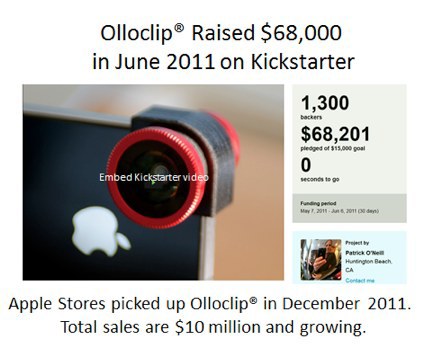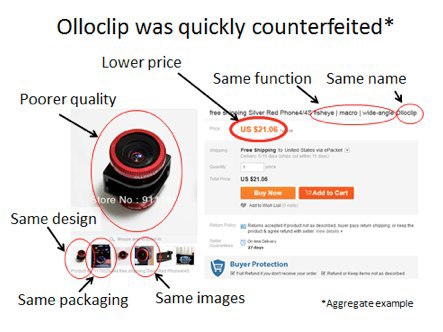Private investigator, patents and illegal import - a little about the struggle of startups with fakes
- Transfer

[from a translator] There was an interesting article on Kabstarter, innovations and disappointments - despite innovations and fresh ideas, many startups suffer from “childhood illnesses” of young business and inability to put things on stream. But frustrations of plans do not always occur due to a lack of business savvy - often scammers come into action, having mastered CTRL + C perfectly. I suggest that you look at the situation from the side of the startup and see how patents help them stay afloat. Of course, in addition to patent trolling competitors.
This is a continuation of a series of articles in which we talk about patents and copyrights as tools to protect our own developments. In the previous series, the issues of protecting the form and design of the product ( The Power of the Broken Line ), security of graphic elements ( The Power of Color ), and protection of designs using the portfolio ( The Power of Portfolio ) have already been considered . Now let's see how trademarks and patents can be used to combat counterfeiting.
One small company
To begin with, let's figure out what “patent protection” means and how it can be used in a difficult struggle with clones. Usually this is an active search for those who want to cash in on your success, followed by playing with your muscles a statement of your rights. Of course, patents and trademarks alone do not insure against the appearance of fakes - if the product is successful, then it is almost certain that someone entrepreneurial will copy it. But as soon as this happened, our hands were untied in the struggle for property.
The article does not just talk about patents and trademark rights. The fact is that the trademark is the very first line of defense in online distribution. Amazon, eBay and Aliexpress-level stores respect them and promptly remove fakes from catalogs at the request of their rightful owners. But if the situation is more serious and we need to stop the massive import of counterfeit products, then design patents will help here.

As an example of the struggle of a small startup with clones, consider the Olloclip project. In 2011, inventor Patrick O'Neill and designer Chong Pak came up with an unusual 3-in-1 interchangeable lens for iPhone. This small device allows you to expand the capabilities of the smartphone’s camera with a set of three lenses: Fish Eye, macro and wide-angle.
Fighting Windmills
In May of that year, developers launched their own company on Kickstarter and in the first month raised more than $ 68,000 to launch production. It was an incredible success. By December, thanks to product success and enthusiastic media reviews, groundbreaking lenses appeared on the Apple Store. A little later, the clones pulled themselves up.

It is simply amazing how quickly and brazenly some craftsmen copy a successful product. The picture above shows a typical clone and its “features”; specifically, this example even appeared a couple of times in the Aliexpress.com directory. It was Olloclip’s regular requirements for online stores that minimized the spread of fakes through this channel.
As soon as the next “competitor-copyist” appears on the online storefronts, Olloclip sends the store a “request to remove from catalogs” store. Usually, after a couple of days, the clone disappears, because the letter actually informs the store about its violation of your intellectual rights. Well-known stores quickly respond to such letters, and if you do not use this, then the copies will very quickly disperse around the world. We all saw thousands of advertisements for the sale of fakes for well-known products - a good example of the sluggishness of the owner of the brand.
In a fake, all the properties of the original are usually copied, with the exception of price and quality. Entrepreneurial "craftsmen" will take photos directly from your page on Kickstarter, borrow the packaging you developed and your name. After that, it remains to reduce the price to 10% of the original - and now the next clone is ready. Its quality at best does not meet accepted standards, and at worst it represents a real danger. I myself have come across more than once fakes that break during the first use. Yes, and on the news regularly pops up reports of a fire or explosion of another Chinese copy.

Finding clones can be both easy and quite troublesome. For example, on sites like Aliexpress it is not difficult, thanks to the grouping of search results by sellers. You are just looking for your brand, get a list of fake sellers and send a warning to the store. Design patents at this stage just will not help, because the store is not able to parse cases of copyright infringement on the product itself. The full power of patents is revealed when you are struggling with the massive import of counterfeit goods in court - then they are irreplaceable.
At the same Amazon, it’s more difficult to find fake sellers, since they are all hidden behind the same product line with the slogan “but I also have such a thing, I can sell it.” You have to make a purchase, make sure that it is a fake and only after that send a notification to Amazon. And yes, you can’t just blame someone for fraud - you need to show evidence. If nothing is done at all, then users will buy up unfinished copies, make sure that they are useless and sincerely believe that you made a bad product. Negative reviews everywhere and a ruined reputation will not take long, and therefore something needs to be done with this.
Small victorious war
The Olloclip reacted to the appearance of another fake quickly and mercilessly. To do this, they filed a full-fledged design patent, and also registered copyrights for the packaging and trademark. The company brought patents to the international level, covering key markets in Europe and China, and even used the services of MarkMonitor. These guys have their own search engine for unauthorized sellers on the Internet with the ability to automatically send alerts to online stores. Their services are not cheap, but very effective.
Such a strategy proved to be good in the fight against most clones, but with the mass distribution of fakes, heavy artillery is required. Olloclip calls on the services of a private detective to find a seller and his warehouse. After which a test purchase is made, evidence is collected, and you can go to court. And in court, patents will come in handy.

Similar to Apple's practice, Olloclip developers filed a detailed patent with a detailed description of their invention. The picture above shows that the product is described in several versions, with dashed and continuous lines to indicate mandatory and optional elements. If someone simply copies the shape of the lens or, for example, the body - it is still covered by the patent. What can we say about copying the whole product.
The company filed a lawsuit on April 15, 2013, in which a certain company Ollo Electronics was accused of violation. In fact, it was 1 person who established the import of copies from China. Despite the attempts of the violator to defend themselves, on August 5, 2013, the court issued a ruling on compensation for damage to the patent holder and the cessation of sales of counterfeit products. Although the fine has not yet been paid.
This is how many intellectual property lawsuits look. In the case of Olloclip, it was a small victorious war with minimal legal costs, which prevented a serious threat to their business. And for others who want to cash in on someone else's glory - a clear demonstration of reckoning.
Shake on the mustache
Several useful lessons can be learned from history:
- Timely registered patents and trademarks are a reliable foundation for protection against fakes;
- If the product is successful, it must be copied;
- Intellectual property protection is not cheap, but without it in any way;
- The trademark is effective in communicating with online stores, and a patent is perfect for combating illegal imports.
“I can’t even imagine how an average startup on Kickstarter can afford all the same things that we did”
Olloclip founder Patrick O'Neill
Not every entrepreneur has the means to put pressure on the court, but they have other effective and inexpensive tools in their hands. Anyone is able to look for fakes in online stores, because sending out claims and evidence is not as complicated as it seems. These measures may well contain most clones. And when the business grows and the product becomes better known, experienced fraudsters can enter the business and you will have to resort to the services of professionals and all available intellectual rights to protect your property.
Without these efforts you will simply be eaten. If everything is done correctly, then you can protect your business and continue the path to success.
[Vadim Sinitsky]





